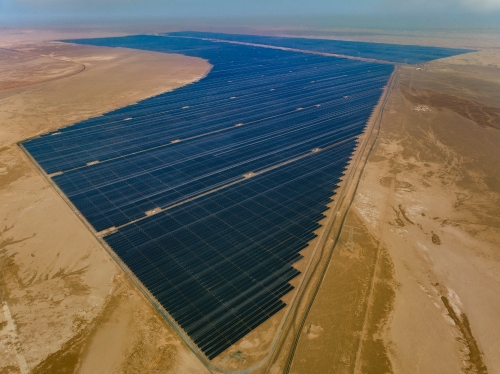The Al Dhafra PV2 Solar Power Plant in the United Arab Emirates, contracted by a Chinese company, was completed in November 2023. (PHOTO: XINHUA)
China is ready to work with the Arab side to put in place "five cooperation frameworks" to step up the building of a China-Arab community with a shared future.
The five frameworks consist of a more dynamic framework for innovation, an expanded framework for investment and finance cooperation, a more multifaceted framework for energy cooperation, a more balanced framework for mutually beneficial economic and trade ties, and a broader framework for people-to-people exchanges.
This year marks the 20th anniversary of the establishment of China-Arab States Cooperation Forum. Through joint efforts, China and Arab states have built a solid foundation for cooperation on energy transition and green development in the past 20 years.
With energy issues being the top agenda for sustainable global development, China is playing a major role in assisting Arab states to achieve their goal of green transition.
Chinese companies have been building more photovoltaic power stations in Arab states including Saudi Arabia, the United Arab Emirates (UAE), Qatar and Egypt, making new energy gradually replace the use of traditional energy by the locals.
For example, the construction of Al Dhafra PV2 Solar Power Plant in the UAE, contracted by a Chinese company, was completed in November 2023. The plant deploys the latest crystalline bifacial solar technology, which captures sunlight from both the front and back of the solar panels and enables it to generate more electricity efficiently.
The plant can generate enough electricity for approximately 200,000 households, reduce 2.4 million tonnes of carbon emissions annually, and raise the ratio of clean energy in the UAE's overall energy structure to over 13 percent. Covering 21 kilometers, the almost four million solar panels have formed an "energy oasis" in Abu Dhabi's desert.
The development of Al Dhafra exemplifies the UAE's commitment to renewable energy and its net-zero goals, according to the World Economic Forum.
The Al Shuaibah Photovoltaic Plant in Saudi Arabia is located in the desert. The solar project was undertaken by three Chinese companies in 2022 and is expected to be operational by 2025. With a total production capacity of 2.6 GW, the plant will generate clean energy to power 450,000 houses in the region annually. It will support Saudi Arabia's goal to generate 50 percent of electricity from renewable sources by 2030.
Apart from collaboration on major renewables infrastructure, China and Arab states are also strengthening cooperation in the electric vehicle industry, which is increasingly playing a part in the energy transition to address the climate change challenges.
With China and the Arab states incorporating sustainable energy into their national development policies, it is expected that both sides will work together to advance more cooperation in renewable energy to build a greener world.
